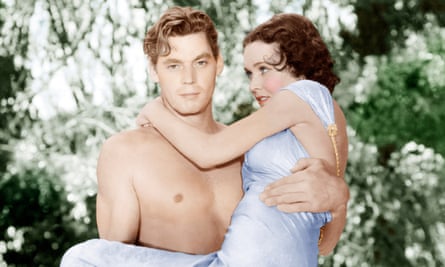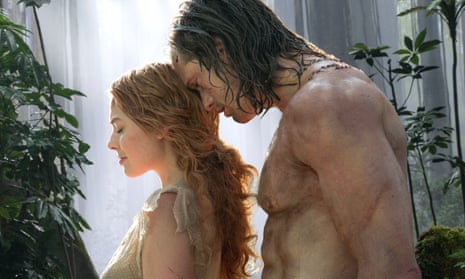There’s a new Tarzan in town. Well, not only in town – clambering through the treetops as well, and swinging around on vines that seem to drop from the clouds. But who cares where he is when he is played in a new film, The Legend of Tarzan, by Alexander Skarsgård of the HBO vampire series True Blood?
This is not the time to split hairs, unless it is one of the long, golden hairs on Skarsgård’s head, in which case take all the time you need.
Tarzan may appear to have travelled a long way since his first silent screen adventure, Tarzan of the Apes, which was released in 1918, six years after Edgar Rice Burroughs’s character made his debut in the October 1912 issue of The All-Story, a pulp magazine. But it is also the case that he has taken a very long time to get back to where he started.
In the 60-odd pictures made about him, though, Tarzan has gone from being an uncomplicated hunk to a troubled toff. In the 1999 Disney animation, he surfed along branches like a beach-bum riding a wave; in the 1975 soft-porn cartoon, Tarzoon: Shame of the Jungle (released in the UK as Jungle Burger), he was a priapic meathead.
The latest version seen in The Legend of Tarzan is probably the closest to the one imagined by Burroughs, which isn’t necessarily a compliment. What makes Tarzan work on the page is very different to the quality needed for a compelling screen hero.
Critics have responded to the latest incarnation with a collective shrug and adjectives such as “uninspiring” (the Guardian), “tame” (Telegraph) and “lifeless” (Variety).
Raised by apes in the jungle after the death of his aristocratic parents, Tarzan – aka John Clayton III, Viscount Greystoke – was strongly connected in Burroughs’s stories (which continued into the 1940s) to both his upper-class origins and his wild beginnings. Most film versions have tended to soft-pedal poshness in favour of pecs.
Only with the rather pompous 1984 adaptation Greystoke: The Legend of Tarzan, Lord of the Apes was a back-story brought into the foreground. The change in emphasis came at the cost of entertainment – unfortunately, the latest picture follows in this tradition. The old ululating yell is still intact, just about, but the loincloth sleeps tonight.
It doesn’t help that Tarzan himself is a bit of a bore – a damp dishrag dressed in a damp dishrag. Only one person has managed to overcome the character’s shortcomings and bring him glowingly to life. Johnny Weissmuller, who made his debut in Tarzan the Ape Man in 1932, had five Olympic gold medals for swimming but no acting experience. It was precisely this artlessness, this lack of technique, that helped to make him the best-loved Tarzan.
The critic Michael Newton said in 2009 that Weissmuller “was relaxed enough even to use his own unfeigned woodenness as an expression of the role”.
Gore Vidal was also a fan. “There is hardly an American male of my generation who had not at one time or another tried to master the victory cry of the great ape that issued from the androgynous chest of Johnny Weissmuller,” he wrote.
That yell was reportedly created by overlaying Weissmuller’s own yodel with the bleat of a camel, the howl of a hyena, the growl of a dog and the sound of a G string being played on a violin.
Not everyone approved of his performance. Hulbert Burroughs, the son of Tarzan’s creator, said: “Dad never liked the way Weissmuller played him – an inarticulate oaf.”
But it was precisely the fumbling nature he brought to the part that made audiences warm to him. Off-screen, too, he had a winning self-deprecation. “I was no actor,” he once confessed. “The director used to say, ‘Get that dumb look on your face.’ ”

Burroughs Sr reportedly favoured Herman Brix, who played the part without much acclaim in a rival Tarzan series between 1935 and 1938.
Burroughs’s idea of Tarzan as a regal figure resurfaced most strongly in 1984’s Greystoke. Its director, Hugh Hudson (Chariots of Fire), certainly talked a good film: “It’s about Adam and Eve, the Garden of Eden. It’s about the loss of innocence and the evolutionary urge. It’s about the freedom of the jungle.” It was also about two and a half hours long.
The film angered traditionalists. Take Victor Davis in the Express in 1984: “This is a Tarzan picture without any live elephants, but that hasn’t stopped Mr Hudson trampling elephant-like over all our memories with his caustic attitude to the likes of the late, great Johnny Weissmuller, and from shying away from all that ‘Me-Tarzan-You-Jane’ business as if we all hated it, which we didn’t.”
But the makers of even the most disappointing Tarzan film will always have one consolation: theirs will never be as ridiculous as Tarzan, the Ape Man, starring Bo Derek, in 1981. Every so often, Derek would disrobe and/or stand under a waterfall; Tarzan himself (Miles O’Keeffe) was left twiddling his thumbs.
This proved to be a problem for Edgar Rice Burroughs Inc, which represents the estate of the author. It refused to sanction a movie in which the Lord of the Apes was reduced to an extra. “It’s not really a Tarzan film,” said a representative. “It’s a Bo Derek film. I don’t think Tarzan should be a bit-player behind Bo Derek.” A judge agreed and ordered a re-edit that put Tarzan back in the picture.
As part of the publicity for the film, the Sun obediently printed a double-page spread about the moment on set when O’Keeffe had apparently saved Derek from the jaws of a lion that had broken free of its tether.
“Bo and I went off to do the love scene on the beach and the lion was left to mull over what happened,” he told the paper.
What poppycock. But still, it has to be said, a lot more fun than The Legend of Tarzan.
The Legend of Tarzan is on release now

Comments (…)
Sign in or create your Guardian account to join the discussion